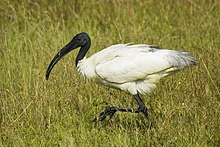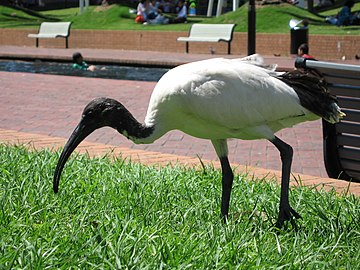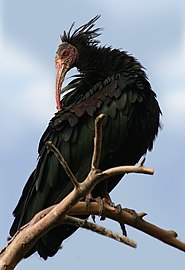Ibisi
| Ibis | |
|---|---|
 | |
| Crnoglavi ibis (Threskiornis melanocephalus) | |
 | |
| Threskiornis spinicollis | |
| Naučna klasifikacija | |
| Domen: | Eukaryota |
| Carstvo: | Animalia |
| Tip: | Chordata |
| Klasa: | Aves |
| Red: | Pelecaniformes |
| Porodica: | Threskiornithidae |
| Potporodica: | Threskiornithinae Poche, 1904 |
| Rodovi | |
| |
Ibisi[1][2][3] ili ibesi[3] je naziv za oko 26 vrsta dugonogih močvarnih ptica koje čine vlastitu potporodicu - Threskiornithinae, unutar porodice - Threskiornithidae u redu Pelikanke.[4] Ove ptice naseljavaju močvare, šume i ravnice.[5] Termin „ibis” je izveden iz latinske i antičke grčke reči za ovu grupu ptica. Isto tako se javlja kao naučno ime čaplje govedarice, (Bubulcus ibis), koja je pogrešno identifikovana 1757. godine kao afrički sveti ražanj.[6]
Karakteristike
Ibisi imaju telo dugo od 55 do 75 cm.[4] Žive po svim toplim krajevima sveta, osim ostrva Južnog Pacifika. Njihovo stanište su plitke lagune, jezera, uvale i močvare gde vole da gacaju koristeći svoje vitke duge noge, u potrazi za malim ribama i mekušcima.[4] Kad lete izduže vrat, a noge zabace potpuno nazad, naizmenično mašu krilima i jedre. Ibisi obično žive u velikim kolonijama, podižući nizove čvrstih gnezda po niskom grmlju ili drveću, u koje polažu tri do pet jaja bele boje, ponekad išarana sa smeđim mrljama.[4]
Vrste
- Najpoznatije vrste
- Crni ibis (Plegadis falcinellus) i njegov bliski rođak bela lica američki ibis (Plegadis chihi) imaju manje telo sa sjajnim tamnocrvenkastim perjem. U kolonijama žive po toplijim krajevima sveta.[4][6][7]
- Hagedaš (Bostrychia hagedash) ili afrički ibis, ima perje zelenkaste boje a poznat je po svom glasnom kreštanju.[4]
- Australski ibis (Threskiornis spinicollis) živi isključivo u Australiji. Za razliku od svojih ostalih srodnika, on se prilagodio uslovima, pa ne živi samo uz vode, hrani se uglavnom skakavcima.[4]
- Grivasti ibis (Geronticus eremita),[8][9][10] je ugrožena vrsta, koja živi po Severnoj Africi i Bliskom istoku. Njegov kljun i koža na golom vratu su crvenkaste boje. Kolonije tih ptica nekad su živele po srednjoj i južnoj Evropi, Siriji i Alžiru, od svih tih kolonija preživele su samo one u Turskoj i Maroku.[4]
- Japanski ibis (Nipponia Nippon) ili Crvenonogi ibis, ima potpuno belo perje sa crvenim licem i nogama. On je ugrožena vrsta, na rubu izumiranja krajem 20. veka.[4]
- Sveti ibis (Threskiornis aethiopicus), živi po južnoj Arabiji i Africi južno od Sahare, a nekad je živeo i po Egiptu, u kojem je u vreme drevnog Egipta bio sveta ptica. On je visok oko 75 cm, belog perja sa crnim vratom, glavom, nogama i pegom na stražnjici.[4]
- Crveni ibis (Eudocimus ruber) živi na severu Južne Amerike, a beli ibis (Eudocimus albus) po Srednjoj i Severnoj Americi.[4]
- Vrste
- Bostrychia bocagei (Chapin, 1923)
- Bostrychia carunculata (Ruppell, 1837)
- Bostrychia hagedash (Latham, 1790)
- Bostrychia olivacea (Du Bus de Gisignies, 1838)
- Bostrychia rara (Rothschild, Hartert & O. Kleinschmidt, 1897)
- Cercibis oxycerca (Spix, 1825)
- Eudocimus albus (Linnaeus, 1758)
- Eudocimus ruber (Linnaeus, 1758)
- Geronticus calvus (Boddaert, 1783)
- Geronticus eremita (Linnaeus, 1758)
- Lophotibis cristata (Boddaert, 1783)
- Mesembrinibis cayennensis (Gmelin, 1789)
- Nipponia nippon (Temminck, 1835)
- Phimosus infuscatus (Lichtenstein, 1823)
- Plegadis chihi (Vieillot, 1817)
- Plegadis falcinellus (Linnaeus, 1766)
- Plegadis ridgwayi (Allen, 1876)
- Pseudibis davisoni (Hume, 1875)
- Pseudibis gigantea (Oustalet, 1877)
- Pseudibis papillosa (Temminck, 1824)
- Theristicus caerulescens (Vieillot, 1817)
- Theristicus caudatus (Boddaert, 1783)
- Theristicus melanopis (Gmelin, 1789)
- Threskiornis aethiopicus (Latham, 1790)
- Threskiornis bernieri (Bonaparte, 1855)
- Threskiornis melanocephalus (Latham, 1790)
- Threskiornis molucca (Cuvier, 1829)
- Threskiornis solitarius (Selys-Longchamps, 1848)
- Threskiornis spinicollis (Jameson, 1835)
- Podvrste
- Bostrychia hagedash brevirostris (Reichenow, 1907)
- Bostrychia hagedash hagedash (Latham, 1790)
- Bostrychia hagedash nilotica (Neumann, 1909)
- Bostrychia olivacea akeleyorum (Chapman, 1912)
- Bostrychia olivacea cupreipennis (Reichenow, 1903)
- Bostrychia olivacea olivacea (Du Bus de Gisignies, 1838)
- Bostrychia olivacea rothschildi (Bannerman, 1919)
- Lophotibis cristata cristata (Boddaert, 1783)
- Lophotibis cristata urschi Lavauden, 1929
- Phimosus infuscatus berlepschi Hellmayr, 1903
- Phimosus infuscatus infuscatus (Lichtenstein, 1823)
- Phimosus infuscatus nudifrons (Spix, 1825)
- Theristicus caudatus caudatus (Boddaert, 1783)
- Theristicus caudatus hyperorius Todd, 1948
- Theristicus melanopis branickii Berlepsch & Stolzmann, 1894
- Theristicus melanopis melanopis (Gmelin, 1789)
- Threskiornis bernieri abbotti (Ridgway, 1893)
- Threskiornis bernieri bernieri (Bonaparte, 1855)
- Threskiornis molucca molucca (Cuvier, 1829)
- Threskiornis molucca pygmaeus Mayr, 1931
Galerija
-
 Crnoglavi ibis
Crnoglavi ibis -
 Australijski beli ibis
Australijski beli ibis -
 Američki beli ibis
Američki beli ibis -
 Grimizni ibis
Grimizni ibis -
 Crni ibis
Crni ibis -
 Threskiornis spinicollis)
Threskiornis spinicollis) -
 Plegadis falcinellus
Plegadis falcinellus -
 Severni ćelavi ibis
Severni ćelavi ibis -
 Hadada ibis
Hadada ibis
Reference
- ^ „ibis”. Dictionary.com Unabridged. Приступљено 6. 10. 2009.
- ^ Fennell, C. A. M., ур. (1892). The Stanford dictionary of Anglicised words and phrases. Cambridge: Cambridge University Press. стр. 453. OCLC 1354115. Приступљено 6. 10. 2009.
- ^ а б Pierce, Robert Morris (1910). Dictionary of Hard Words. New York: Dodd, Mead & Company. стр. 270. OCLC 4177508. Приступљено 6. 10. 2009.
- ^ а б в г д ђ е ж з и ј „Ibis” (на језику: engleski). Encyclopædia Britannica. Приступљено 23. 9. 2012. CS1 одржавање: Непрепознат језик (веза)
- ^ Longrich, N. R.; Olson, S. L. (5. 1. 2011). „The bizarre wing of the Jamaican flightless ibis Xenicibis xympithecus: a unique vertebrate adaptation”. Proceedings of the Royal Society B: Biological Sciences. 278 (1716): 2333—2337. PMC 3119002
 . PMID 21208965. doi:10.1098/rspb.2010.2117.
. PMID 21208965. doi:10.1098/rspb.2010.2117. - ^ а б Jobling, James A (2010). The Helm Dictionary of Scientific Bird Names. London: Christopher Helm. стр. 201. ISBN 978-1-4081-2501-4.
- ^ Santoro, Simone; Sundar, K.S.G.; Cano-Alonso, L.S. (2019). „Glossy Ibis ecology and conservation”. SIS Conservation. 1: 1—148. ISBN 978-2-491451-01-1.
- ^ Gesner (1555) pp. 337–8 "Corvo sylvatico"
- ^ Rare Birds Yearbook 2009. England: MagDig Media Limited. 2008. стр. 114—115. ISBN 978-0-9552607-5-9.
- ^ Pegoraro, Karin; Föger, Manfred; Parson, Walther (октобар 2001). „First evidence of mtDNA sequence differences between Northern Bald Ibises (Geronticus eremita) of Moroccan and Turkish origin”. Journal of Ornithology. 142 (4): 425—28. S2CID 11075005. doi:10.1007/BF01651340. CS1 одржавање: Формат датума (веза)
Literatura
- Cramp, Stanley; Perrins, C.M.; Brooks, Duncan J., ур. (1994). Handbook of the Birds of Europe, the Middle East, and North Africa: The Birds of the Western Palearctic. Oxford University Press. ISBN 978-0198546795.
- Field Guide to the Birds of North America (4th изд.). National Geographic Society. 1987.
- Sundar, K.S.G.; Kittur, S. (2019). „Glossy Ibis Distribution and Abundance in an Indian Agricultural Landscape: Seasonal and Annual Variations” (PDF). SIS Conservation. 1: 135—138.
- Máñez, M.; et al. (2019). „Twenty two years of monitoring of the Glossy Ibis Plegadis falcinellus in Doñana”. SIS Conservation. 2019: 98—103.
- Champagnon, J.; et al. (2019). „The Settlement of Glossy Ibis in France”. SIS Conservation. 2019: 50—55.
- „Rykind af sorte ibisser i danske vådområder” (на језику: дански). Danish Ornithological Society. 20. 5. 2022. Приступљено 28. 1. 2023. CS1 одржавање: Формат датума (веза)
- „Glossy ibis Plegadis falcinellus (Linnaeus, 1766)”. New Zealand Birds Online. Приступљено 16. 1. 2019. CS1 одржавање: Формат датума (веза)
- Santoro, S.; Champagnon, J.; Kharitonov, S.P.; Zwarts, L.; Oschadleus, H.D.; Manez, M.; Samraoui, B.; Nedjah, R.; Volponi, S.; Cano-Alonso, L.S. (2019). „Long-distance Dispersal of the Afro-Eurasian Glossy Ibis From Ring Recoveries” (PDF). SIS Conservation. 1: 139—146.
- Mourer-Chauviré, Cécile; Philippe, Michel; Guillard, Stéphane; Meyssonnier, Marcel (јул 2006). „Presence of the Northern Bald Ibis Geronticus eremita (L.) during the Holocene in the Ardèche valley, southern France”. Ibis. 148 (4): 820—23. doi:10.1111/j.1474-919X.2006.00563.x. CS1 одржавање: Формат датума (веза)
- Boev, Zlatozar (2000). „Additional material of Geronticus balcanicus Boev, 1998, and precision of the age of the type locality” (PDF). Acta Zoologica Bulgarica. 52 (2): 53—58. Архивирано из оригинала (PDF) 2011-08-15. г. Приступљено 2008-12-29.
- Marco, Antonio Sanchez (јул 1996). „The presence of the Waldrapp Geronticus eremita (Plataleidae) in the Plio-Pleistocene boundary in Spain” (PDF). Ibis. 138 (3): 560—61. doi:10.1111/j.1474-919X.1996.tb08081.x. CS1 одржавање: Формат датума (веза)
- Boev, Zlatozar (1998). „Presence of Bald Ibises (Geronticus Wagler, 1832) (Threskiornithidae - Aves) in the Late Pliocene of Bulgaria”. Geologica Balcanica. 28 (1–2): 45—52. doi:10.52321/GeolBalc.28.1-2.45.
- Gesner, Conrad (1555). Historiæ animalium liber III qui est de auium natura. Adiecti sunt ab initio indices alphabetici decem super nominibus auium in totidem linguis diuersis: & ante illos enumeratio auium eo ordiné quo in hoc volumine continentur (на језику: латински). Zurich: Froschauer.
- Serra, Gianluca; Peske, L.; Wondafrash, M. (2007). Preliminary survey of Middle Eastern Northern Bald Ibises at their recently discovered wintering grounds in Ethiopian highlands. Report, BirdLife International / Royal Society for the Protection of Birds.
- Serra, Gianluca; Wondafrash, M. (2009). Eco-ethological and conservation survey of N. Bald Ibises wintering in the northern Shawa (Ethiopia) during 2008–09. Report, EWNHS / IUCN / DGCS Trust Fund pilot project, 39 pp.
- Serra, Gianluca; Nahaz, M.M.; Idan M.; Peske L.; Savioli A.; Bruschini C.; Alomari K. (2009). Assessment and characterization of the Ibis Protected Area in the Palmyra Desert - a proposed 5-year management and development framework. IUCN publication.
- Serra, Gianluca (2010). Northern Bald Ibis Expedition in Saudi Arabia, March 2010. Report, IUCN and National Geographic Soc., 34 pp.
- G. Serra; et al. (2008). „Feeding ecology and behaviour of last surviving middle eastern N. Bald Ibises breeding in the Syrian steppe”. Zoology in the Middle East. 43: 55—68. S2CID 87023621. doi:10.1080/09397140.2008.10638269.
- G. Serra; et al. (2013). „An assessment of ecological conditions and threats at the Ethiopian wintering site of the last known eastern colony of critically endangered Northern Bald Ibis Geronticus eremita”. Bird Conservation International. 23 (4): 399—413. doi:10.1017/s0959270913000397
 .
. - G. Serra; et al. (2009). „Breeding ecology of the last oriental N. Bald Ibises in the Syria desert”. Journal of Ornithology. 150 (4): 769—782. S2CID 26090442. doi:10.1007/s10336-009-0398-y.
- G. Serra; et al. (2015). „Accounting for very low survival of a Critically Endangered bird on a major migratory flyway”. Oryx. 49 (2): 312—320. doi:10.1017/s0030605313000665
 .
.
Spoljašnje veze

- Ibis na portalu Encyclopædia Britannica
- Ibis videos – at Internet Bird Collection
 „Ibis”. New International Encyclopedia. 1905.
„Ibis”. New International Encyclopedia. 1905.




















